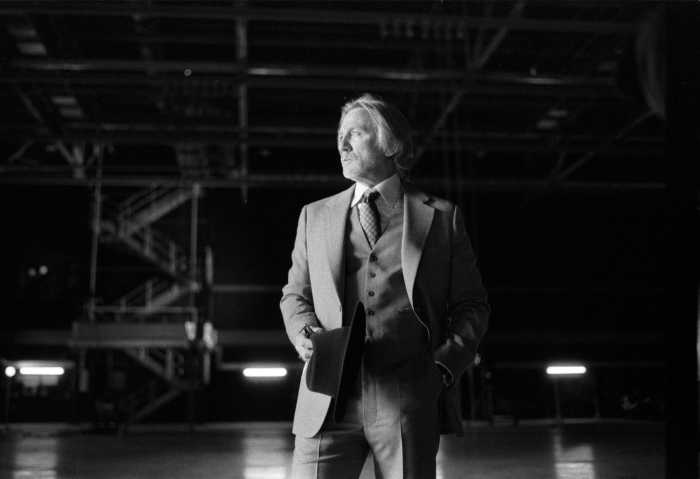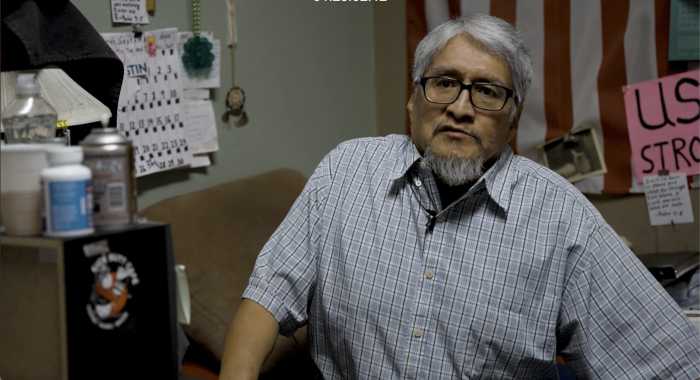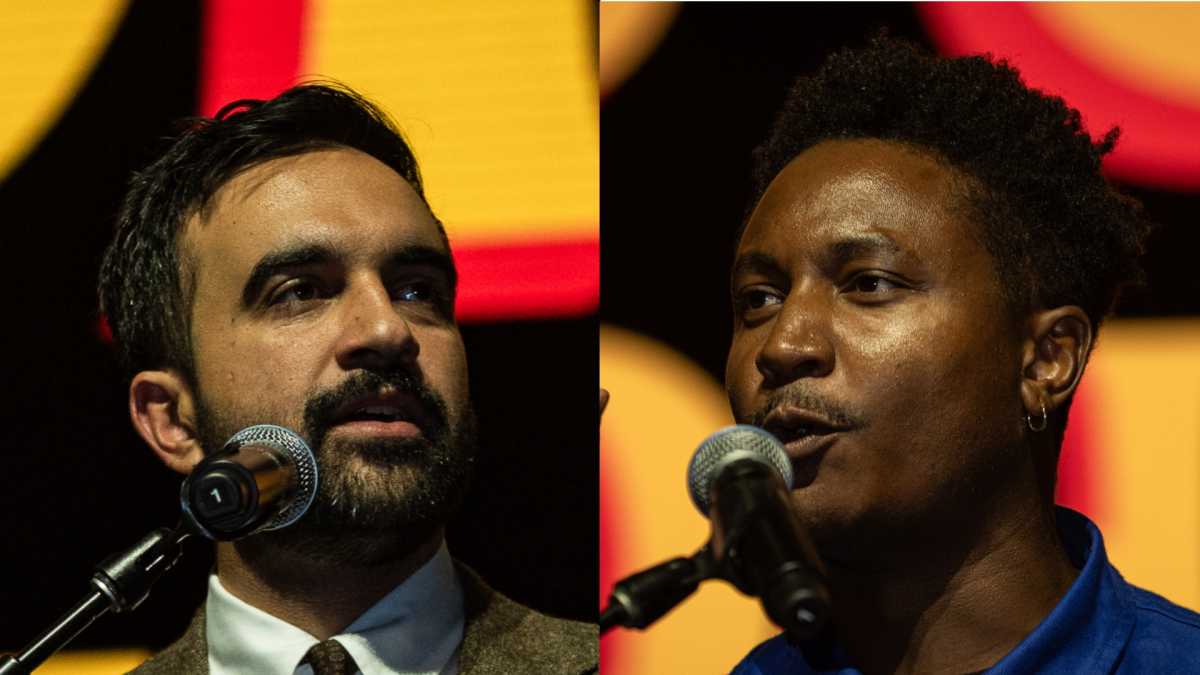Author and screenwriter Sherman Alexie directed his only feature film, “The Business of Fancydancing,” back in 2002. The drama stars out actor Evan Adams as Seymour Polatkin, a gay Native American poet who returns home to his reservation (rez) after the death of a friend.
Seymour, who has become successful in white society, has to contend with the attitudes of his former best friend, Aristotle (Gene Tagaban) and others, including a thorny interviewer (Rebecca Carroll). He gets some comfort from his college girlfriend, Agnes (Michelle St. John), and his current white boyfriend, Steven (Kevin Phillip).
The film, which has just been gloriously restored, reunites Adams and Alexie, who first collaborated on the acclaimed 1998 indie, “Smoke Signals.” The filmmaker and actor spoke with Gay City News about their provocative film on the eve of its re-release.
Sherman, what prompted you to make this film? Surely, it was an uphill climb to tell a story about Native Americans, especially two decades ago, but you increase the degree of difficulty by making Seymour a gay poet, and the film experimental.
Sherman Alexie: Those are all the reasons why I wanted to make it. In some sense, the mainstream success of “Smoke Signals” drove me to make something that wasn’t mainstream. I wanted to do something more literary. I’m extremely happy with “Smoke Signals.” It still has an enormous life in the Native world especially. But I wanted to do something more weird. I wasn’t aiming to for a mainstream film career. I would have been happy if “Fancydancing” received the audience “Smoke Signals” did, but I purposely chose non-mainstream topics: experimental, gay, Indian, poet.
Evan Adams: Sherman said, “Let’s do a film where your character’s gay.” Sherman’s not gay. Why would he do that? I could go there. He is brave, of course I’ll go there with him.
Sherman Alexie: People who haven’t seen the film before may miss out on that it was pretty damn revolutionary in 2002, politically and culturally. It was rather unprecedented to have a gay Native male as a protagonist. Evan and I were ahead of our time, and 23 years later, we still might be. I am proud of that and that our weird little move is having a second life thanks to the re-release.
Evan, Seymour does a lot of codeswitching, and “performing.” What observations do you have about that?
Evan Adams: I felt like Seymour was what Sherman and I were living. We were rez boys who were having great success. We were educated and free and had resources. We didn’t have a word for codeswitching back them. We knew we were different at home than in the city, and at work and with our lovers. What did all that mean?
Sherman, can you talk about how you conceived of and constructed the multiple layers in the film both visually and narratively?
Sherman Alexie: I always knew it was going to be episodic in a sense. I saw it originally as a series of short films. The film that I was obsessed with that time was “Thirty Two Short Films About Glenn Gould.” In the editing room, I started playing with time and adding more of the mosaic quality. The movie’s fragmented sense matched Seymour’s fragmented identity.
Evan, how did you envision Seymour’s character?
Evan Adams: I really was trying to capture Sherman. I am not a poet who does performances. That was grueling doing a reading in front of Sherman. I couldn’t match him.
What I was feeling at the time was, as a gay man and an artist, you have to be able to walk away from people, even people you love who want to tear you away. Steven wanted Seymour to stay home and stop being so provocative and Seymour’s home community says, “You have money and you travel and you are so arrogant, you should be a humble person.” I felt Seymour has to tell the truth even if you hate me. It was fraught. In every scene, I was not likable. You are taught as an actor to make your characters relatable, but the truth is, he’s going to do what he’s going to do — that’s his power.
Sherman, you include snippets of Shakespeare and the Kaddish in a film about cultural appropriation. Thoughts on that?
Sherman Alexie: I have a poem where I am a culturally omnivorous. Hunger is my crime. I am a part of everything. Michelle St. John [who performs the Kaddish] is actually half Jewish. It is fairly common in Toronto in the arts and political world that there are a lot of Jewish First Nations intermarriage. I wanted to make that part of Agnes’ Identity. The trickery is that people think she is singing a native song and it’s actually Kaddish. And the last song in the movie people think is a traditional native song. Michelle did the melody, and I wrote the lyrics, which my mom and aunt translated into Spokane; it’s basically a paraphrase of “You’re So Vain” by Carly Simon. I’m a multicultural guy, and the pressure on Native Americans and First Nations people is to only be Indian and only live within a narrow range of Indian identity. I find that hilarious.
Evan and I are rez guys. When you think of what Indian is, the dominant image is rez guys. An overwhelming percent of Native American artists are not from the rez, and they go to towards this idea of pure Indian-ness, where that is all they are. But I go in the reverse. That is not all I am. I spent as much time watching movies on VCR as going to Powwow. Even on the rez, living in the basement of government housing, I was cross-cultural. I wanted Seymour to make that very explicit. Evan and I blended this character. He’s gay because Evan is gay. He is college educated because we were college educated.
Evan, does Seymour have shame and self-loathing, or imposter syndrome? He has an air confidence that some might see as arrogance.
Evan Adams: I wasn’t playing arrogance; I was playing someone competent in more areas than most people. My reach exceeds my grasp. He is constantly thinking, what is the best I can attain in this moment? He really does think everything he does he has to do with enormous fire or why even show up? Maybe that looks like arrogance? But when I was little boy and doing Indian dancing, I was very precise. I would watch the other boys, and the tips of their hands were not sharp like an eagle’s wing, they were lazy and sloppy. Seymour is reaching. He is not being laid back; he is not being your average guy.
Sherman and I have often talked about how many people try to “out Indian” us. I’d meet someone who would say, “You think you’re so good. Let’s go toe to toe.” I don’t want to fight everywhere I turn. If you’re trying to outdo me, well, get in line, or do it — show me. But it does get tiring when you get people trying to “out Indian” you.
Sherman Alexie: If you think you’re more Indian than me, my answer is that I am pretty much more Indian than everybody. [Laughs] Part of the aesthetic of this film is that you’re supposed to present likable characters, especially movies with minority figures. The Indians especially want all the Indians to be likable. That’s universal among communities. The idea of writing characters who are not always likable and charming and do have edges is rather revolutionary. If you look at the history of Native America representations in cinema, it is an unacknowledged stereotype that they are always likable. If they are bad, you think of Wes Studi’s character in “The Last of the Mohicans,” who is like a Darth Vader figure. I like having a complicated contemporary character like Seymour or Aristotle. who are difficult.
What can you say about leaning into or away from stereotypes about Native Americans?
Sherman Alexie: I do depict social dysfunction in a lot in my work. The Meta answer is human literature is the story of dysfunction. “The Odyssey” is not a travelogue. “Hamlet” is not a happy-go-lucky fellow. “The House of Mirth” is not mirthy. Part of the feeling that we are presenting stereotypes is condescending. That we are somehow separate and above or below human literature is wrong. Why can’t we be as complicated as Hamlet? Why can’t we write something as complicated as “The House of Mirth?” Why can’t we to aspire to be “Apocalypse Now”? Why can’t we have those ambitions? Why are we always measured by the social work scale?
My second answer is autobiographical. My dad died of alcoholism. All of my aunt and uncles, save two, died of alcohol. I have cousins who spent time in penitentiaries fueled by alcohol and drugs. My sister died in a house fire after a drunken party. This film is autobiographical in terms of the addictions and alcoholism. I, myself, am an alcoholic. I have been sober for 34 years.
Evan Adams: I was always tired of stereotypes because they are not that interesting to play. We have never seen a gay man [on screen] like Seymour who is uber-successful and smart and wasn’t going to be an Uncle Tom or be nice to make you comfortable. I thought, how many of us hide our light or dumb ourselves down or make ourselves likable or nice?
Sherman Alexie: That’s an interesting point. The expected demeanor has changed for Natives as well. Now you get rewarded for kind of being an asshole, especially on social media; you get rewarded for being publicly cruel.
There is a line in the film about Seymour’s success being a way to “tell others we’re still here.” Can you talk about ideas of visibility
Evan Adams: Sherman and I are creatures of privilege. However, we got to the power we have, so with Seymour, you see a powerful indigenous man. He’s not victimized. Having that power was what we were trying to put forward. That’s what I loved as well about “Smoke Signals” — these are powerful men who are reaching, and hopefully the audience can live that, and that empowers them as well.
Sherman Alexie: The word that popped into my mind was “intact” The stories about our cultural demise are not really true. We are not the Indians of 200, 100, 50, or 20 years ago. We are intact and we evolve. People don’t think of Native people as evolving. I think you can call Seymour an evolving character, and in that evolution, he has found power. He is a kind of storyteller who extends the notion of traditional storytelling.
Sherman Alexie will participate in a post-screening talkback on Nov. 14 after the 7 pm show at the Quad Cinema.
“The Business of Fancydancing” | Directed by Sherman Alexie | Opening November 14 at the Quad Cinema | Distributed by Kino Lorberncydancing” | Directed by Sherman Alexie | Opening November 14 at the Quad Cinema | Distributed by Kino Lorber and Milestone Film



































